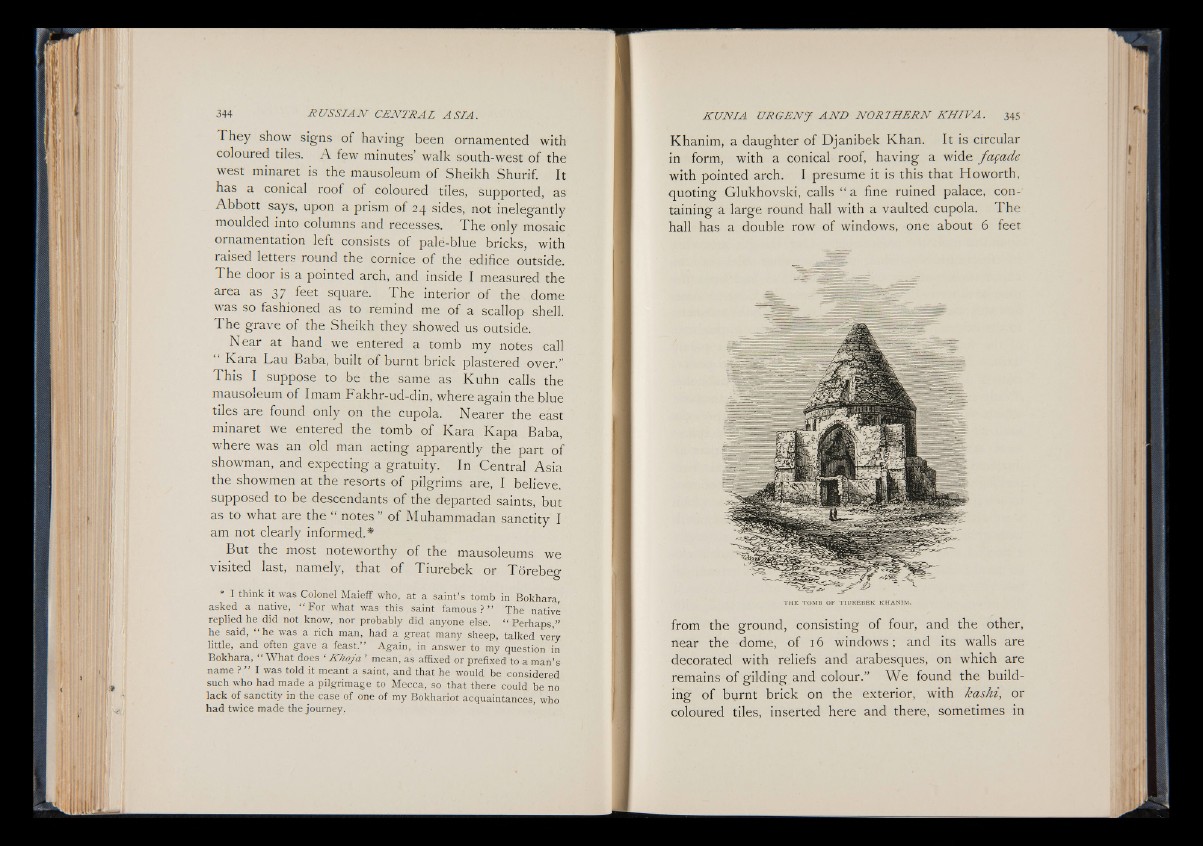
T hey show signs of having been ornamented with
coloured tiles. A few minutes’ walk south-west of the
west minaret is the mausoleum of Sheikh Shurif. It
has a conical roof of coloured tiles, supported, as
Abbott says, upon a prism of 24 sides, not inelegantly
moulded into columns and recesses. The only mosaic
ornamentation left consists of pale-blue bricks, with
raised letters round the cornice of the edifice outside.
The door is a pointed arch, and inside I measured the
area as 37 feet square. The interior of the dome
was so fashioned a,s to remind me of a scallop shell.
The grave of the Sheikh they showed us outside.
Near at hand we entered a tomb my notes call
Kara Lau Baba, built of burnt brick plastered over.”
This I suppose to be the same as Kuhn calls the
mausoleum of Imam Fakhr-ud-din, where again the blue
tiles are found only on the cupola. Nearer the east
minaret we entered the tomb of Kara Kapa Baba,
where was an old man acting apparently the part of
showman, and expecting a gratuity. In Central Asia
the showmen at the resorts of pilgrims are, I believe,
supposed to be descendants of the departed saints, but
as to what are the “ notes ” o f Muhammadan sanctity I
am not clearly informed.*
But the most noteworthy of the mausoleums we
visited last, namely, that of Tiurebek or Torebeg
* I think it was Colonel Maieff who, at a saint’s tomb in Bokhara,
asked a native, “ For what was this saint famous?” The native
replied he did not know, nor probably did anyone else. “ Perhaps ”
he said, “ he was a rich man, had a great many sheep, talked very
little, and often gave a feast.” Again, in answer to my question in
Bokhara, “ What does ‘ Khoja ’ mean, as affixed or prefixed to a man’s
name ? ” I was told it meant a saint, and that he would be considered
such who had made a pilgrimage to Mecca, so that there could be no
lack of sanctity in the case of one of my Bokhariot acquaintances, who
had twice made the journey.
Khanim, a daughter of Djanibek Khan. It is circular
in form, with a conical roof, having a wide façade
with pointed arch. I presume it is this that Howorth,
quoting Glukhovski, calls “ a fine ruined palace, containing
a large round hall with a vaulted cupola. The
hall has a double row of windows, one about 6 feet
from the ground, consisting of four, and the other,
near the dome, of 16 windows; and its walls are
decorated with reliefs and arabesques, on which are
remains of gilding and colour.” We found the building
of burnt brick on the exterior, with kashi, or
coloured tiles, inserted here and there, sometimes in